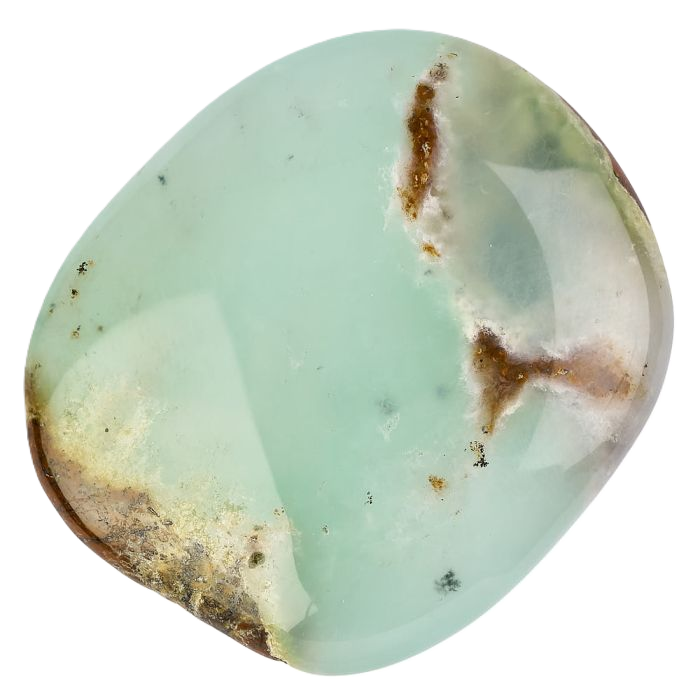
The name chrysoprase comes from Greek chrysos “gold” + prasinon “leek-green”, a nod to its luminous green colour. You may also see chrysophrase, chrysoprasus (older spellings), nickel chalcedony, or trade names like “Australian jade”
Composition, Physical Characteristics & Varieties
- Species: A chalcedony (microcrystalline quartz) variety.
- Chemistry: SiO₂ coloured by traces of nickel (Ni²⁺), typically as minute inclusions of nickel-bearing phyllosilicates such as pimelite/kerolite/willemseite.
- Appearance: Translucent apple-green to deeper grassy green; waxy to vitreous lustre; usually cut as cabochons, beads and carvings.
- Hardness: ~6–7 on the Mohs scale; SG ~2.6; no cleavage; conchoidal fracture.
- Look-alikes: Chrome chalcedony (green from chromium, not nickel) can resemble high-grade chrysoprase.
Notable Varietal Terms
- Australian chrysoprase: celebrated for saturated, even colour.
- Prase (general term): sometimes used for darker green chalcedony but also for chlorite-coloured quartz—so usage varies.
Where Chrysoprase Is Found
Historic and modern sources include Australia (Queensland, Western Australia), Indonesia (Java), Tanzania (Haneti), Poland (Szklary/Lower Silesia), Germany, Russia (Urals), Brazil, and the USA (Arizona, California). Many deposits form by lateritic weathering of nickel-rich ultramafic rocks.
Archaeological & Significant Finds, Historical & Current Usage
- Medieval–Renaissance Bohemia: The St Wenceslas Chapel (St Vitus Cathedral, Prague) famously uses polished panels of amethyst, jasper and chrysoprase in its stone dado—an early prestige use of the gem in sacred art.
- 18th-century Prussia: Frederick the Great prized Silesian chrysoprase for decorative arts and palace ornament, reserving the stone by royal prerogative.
- Today: Chrysoprase is widely used in fine and designer jewellery, intarsia, beads and sculptural carvings. Its even, glowing colour makes it a favourite for cabochons and statement pieces.
Interesting Facts
- Chrysoprase is the most valuable chalcedony colour variety when colour is rich and translucent.
- Its colour arises from nickel, unlike emerald (chromium/vanadium) or chrome chalcedony (chromium).
- Some material—especially dyed stones or certain European nodules—may fade under strong sunlight or heat; Australian material is typically more stable.
Folklore, Superstition, Legends & Tales
- Linked with spring, growth and good fortune, chrysoprase was a talisman for prosperity and eloquence in European lore.
- A popular medieval tale says Alexander the Great wore chrysoprase for victory; when it was lost, his fortunes waned—an allegory about courage and clear judgement.
- In Central Europe it was sometimes set in amulets for protection and truthful speech.
Mystical Healing Properties (complementary/spiritual use)
- Heart soothing & emotional renewal: eases anxiety, softens resentment, supports forgiveness and inner child work.
- Confidence & expression: promotes honest communication from the heart; balances self-worth with kindness.
- Abundance mindset: often used in rituals for luck, growth and fresh starts.
Note: Spiritual properties are not a substitute for medical advice.
Astrology & the Zodiac
- Planetary affinity: Venus (beauty, harmony, attraction).
- Zodiac resonance: often associated with Taurus (Venus-ruled), Gemini (clear, kind speech) and Libra (balance).
- Birthstone link: a widely recognised alternative birthstone for May (beside emerald); some jewellers also highlight it as a Gemini stone.
Chakras
- Heart Chakra (Anahata): primary—compassion, renewal, self-acceptance.
- Solar Plexus (Manipura): secondary—gentle confidence, will aligned with kindness.
- Throat (Vishuddha): supportive—speaking truth with grace.
Birthstone & Wedding Anniversary
- Birthstone: May (alternative)—ideal for those seeking a gentler, more affordable green stone than emerald.
- Wedding anniversary: often given for the 18th anniversary in modern gemstone lists.
Crystal Pairings: What Works Well & What to Avoid
Works Beautifully With
- Rose Quartz, Morganite, Rhodonite: deepen heart healing and self-love.
- Aventurine, Emerald, Peridot: amplify growth, luck and renewal.
- Amazonite, Aquamarine: compassionate communication; calm the nerves.
- Clear Quartz, Selenite: gentle cleansing and amplification without overwhelm.
Use Cautiously or Avoid (depending on intention)
- High-octane activators (Moldavite, Libyan Desert Glass, phenacite) can overpower chrysoprase’s soft energy during delicate heart work.
- Very grounding/protective stones (Black Obsidian, Hematite) may feel “heavy” if your goal is lightness and emotional opening—blend intentionally and notice how you feel.
- Dyed or mislabelled stones (sold as “chrysoprase”) can muddy energy and value—buy from reputable sources.
Care, Storage & Buying Tips
- Light & heat: avoid prolonged sunlight/heat—some chrysoprase (especially dyed or certain European material) may lighten; store cool and shaded.
- Cleaning: lukewarm soapy water, soft cloth; no ultrasonic/steam.
- Storage: separate pouch/box to prevent scratches; keep away from harsh chemicals.
- Buying: look for even, saturated green, pleasing translucency, minimal fractures; ask about treatments (dyeing is common in lower-grade material).
